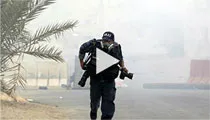President Faure Gnassingbé and his allies used the multiple levers of power to dominate the political and media landscapes. Coverage of dissenting political views came under attack from government regulators who censored critical programming, and from security agents who violently obstructed journalists covering protests. Government regulators barred a popular current affairs call-in radio program in July, while continuing their two-year-old ban on another station known for its vernacular political debate program. Street protests against human rights violations and abuses of power flared throughout the year but were violently dispersed by security forces. CPJ documented at least three instances in which security agents or police assaulted journalists covering the demonstrations. Journalists filming or photographing police dispersal tactics were targeted. Ahead of parliamentary elections scheduled for 2013, Gnassingbé’s ruling majority in the National Assembly passed legislation giving its loyalists control over local polls and vote counting, setting off another round of public protests by the opposition, according to news reports.
Togo
» Government regulators censor political commentary, dissenting views.
» Police attack journalists covering anti-government demonstrations.
President Faure Gnassingbé and his allies used the multiple levers of power to dominate the political and media landscapes. Coverage of dissenting political views came under attack from government regulators who censored critical programming, and from security agents who violently obstructed journalists covering protests. Government regulators barred a popular current affairs call-in radio program in July, while continuing their two-year-old ban on another station known for its vernacular political debate program. Street protests against human rights violations and abuses of power flared throughout the year but were violently dispersed by security forces. CPJ documented at least three instances in which security agents or police assaulted journalists covering the demonstrations. Journalists filming or photographing police dispersal tactics were targeted. Ahead of parliamentary elections scheduled for 2013, Gnassingbé’s ruling majority in the National Assembly passed legislation giving its loyalists control over local polls and vote counting, setting off another round of public protests by the opposition, according to news reports.
All nine seats on the Broadcast and Communications High Authority, also known by its French acronym HAAC, are controlled by the ruling party, according to a December 2009 law. The agency censures news outlets and refers cases to the courts, which can impose suspensions and fines.
| 4 | Members appointed by the president |
| 5 | Members named by the ruling party-dominated National Assembly |
The government invoked regulatory powers to suspend news outlets over critical reporting during politically sensitive periods such as the run-up to October legislative elections, according to CPJ research.
Radio X-Solaire, a community station operating in the capital, Lomé, was forced off the air in November 2010 when government regulators sealed its studios, citing technical and administrative violations, according to news reports. Local journalists believe the closing was linked to a popular debate program in which journalists and politicians offered commentary that was often critical of the government.
November 29, 2010: | Agents of the Regulatory Authority for Telecommunications and Posts (ARTP) seal the station’s studios, saying its equipment is substandard and that it lacks an official document authorizing its frequency. |
February 18, 2011: | Journalists organize a concert to protest the closing. |
January 18, 2012: | The Ministry of Territorial Administration issues the station an official frequency document. HAAC and ARTP order the station to file a new application to obtain a new frequency. |
January 19, 2012: | Journalists stage a protest march demanding the station’s reopening. |
March 6, 2012: | A judge orders ARTP to immediately reopen Radio X-Solaire or pay a daily fine. |
March 7, 2012: | ARTP appeals judge’s decision. |
Police and security forces attacked at least three journalists covering the violent dispersal of anti-government protests. In each case, the journalist suffered injuries and was prevented from documenting police actions. Attacks by police constitute most of the anti-press assaults documented by CPJ.

